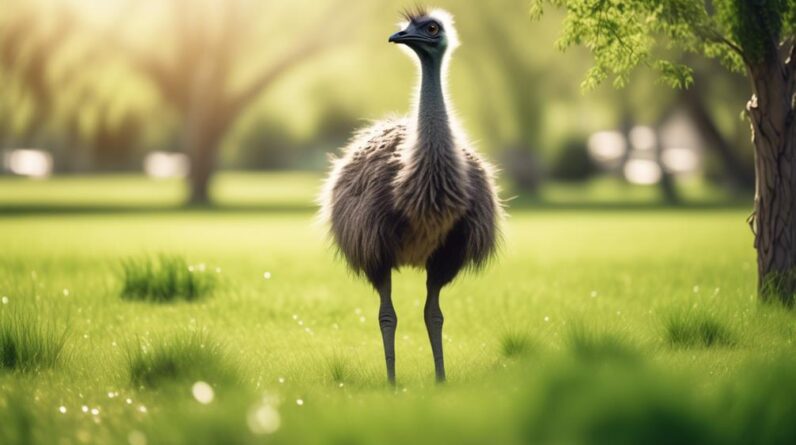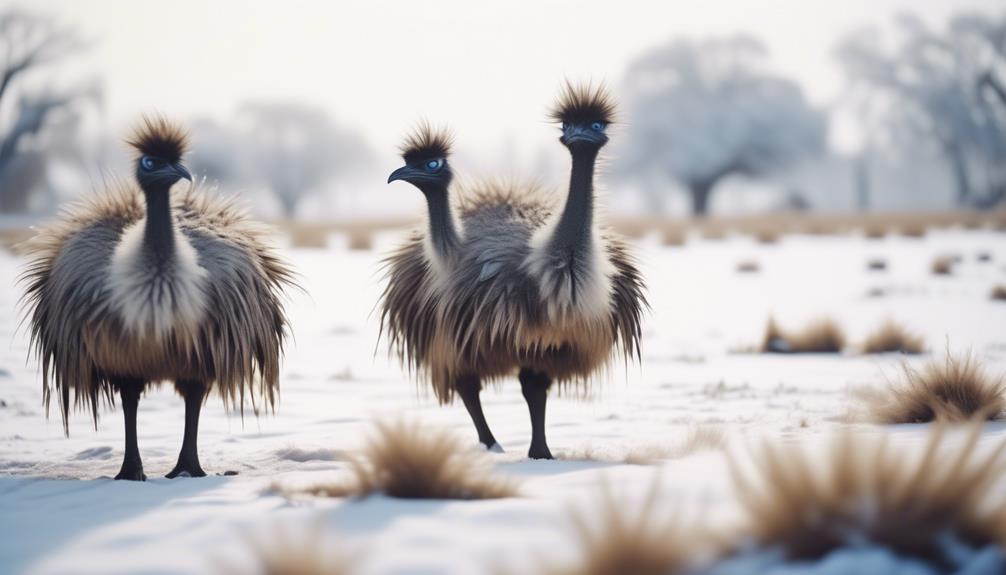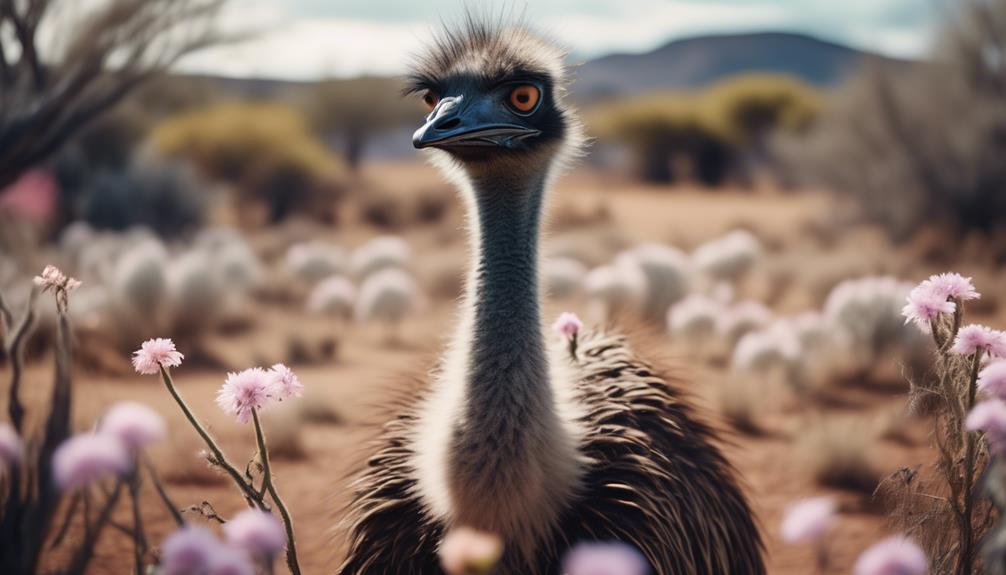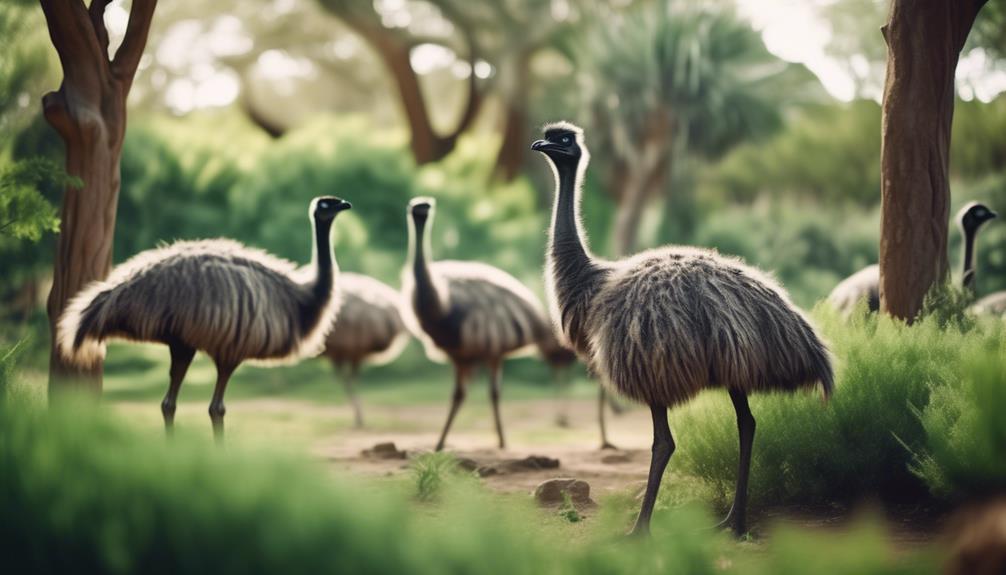
Have you ever wondered how seasonal changes affect emus? These fascinating flightless birds are known for their adaptability to different environments, but how do they cope with the fluctuations in weather and climate?
From their breeding season to migration patterns, emus display a range of behaviors and physiological changes in response to seasonal variations.
In this discussion, we will explore the effects of seasonal changes on emus, including their breeding rituals, feeding patterns, and behavioral adaptations.
Additionally, we will delve into the impact of climate change on these unique creatures and the conservation measures being taken to protect their population.
So, let's embark on a journey to unravel the secrets of how emus navigate through the ever-changing seasons.
Key Takeaways
- Emus undergo physiological changes during breeding season, including increased reproductive hormones and structural changes in reproductive organs.
- Emus exhibit elaborate courtship displays and participate in shared nest construction and incubation, demonstrating their involvement in reproductive responsibilities.
- Emus adapt their feeding habits and migration behavior based on seasonal changes and food availability, showcasing their resilience and navigational skills.
- Emus undergo molting and seasonal plumage changes, which serve purposes such as camouflage, insulation, and adaptation to different weather conditions. These changes also impact their health and energy levels.
Breeding Season
During the breeding season, Emus undergo specific physiological and behavioral changes in order to maximize reproductive success. These changes are crucial for their breeding success and are driven by a combination of hormonal fluctuations and environmental cues.
One of the most noticeable changes in Emus during the breeding season is their reproductive behavior. Male Emus become more territorial and engage in elaborate courtship displays to attract females. They puff up their feathers, stretch their necks, and emit low booming sounds to establish dominance and signal their readiness to mate. Females, on the other hand, become more receptive to mating during this time. They respond to the males' displays by approaching them and showing a heightened interest in courtship behaviors.
Physiologically, Emus also experience changes during the breeding season. The levels of reproductive hormones, such as testosterone and estrogen, increase in both males and females. These hormonal changes stimulate the development of reproductive organs and enhance the production of gametes. Additionally, the reproductive organs of male Emus undergo structural changes, including an increase in testis size, to support the production and delivery of sperm.
Nesting and Egg Incubation
As Emus progress from the breeding season, their focus shifts to nesting and egg incubation, where they exhibit distinct behaviors and undergo physiological changes to ensure the successful development and hatching of their eggs. Emu care during this period is crucial, as the parents must provide a safe and nurturing environment for their developing offspring.
During nesting, the female emu constructs a shallow nest by scraping a depression in the ground with her legs. She then lines the nest with leaves, grass, and other materials to provide insulation and protection. The male emu plays an active role in this process, guarding the nest and participating in incubation.
Incubation is a critical stage, as it ensures the optimal conditions for the eggs' development. Emus have a strong parental instinct, and both the male and female take turns incubating the eggs. This shared responsibility allows for constant temperature regulation and ensures the eggs receive adequate care.
To give you a better understanding, here is a table summarizing the main behaviors and physiological changes observed during nesting and egg incubation:
| Behaviors | Physiological Changes |
|---|---|
| Nest construction | Increased nesting hormones |
| Incubation | Decreased appetite |
| Shared responsibility | Increased body temperature |
As Emus diligently tend to their eggs, their parental instinct drives them to provide the necessary care and support. Through these behaviors and physiological changes, Emus ensure the successful development and hatching of their precious offspring.
Mating Rituals

Emus engage in elaborate mating rituals, displaying a series of distinctive behaviors and vocalizations to attract a suitable mate. These courtship behaviors are crucial for their reproductive success, ensuring the continuation of their species.
During the mating season, male emus compete for the attention of females by showcasing their physical prowess and attractiveness. Here are four key courtship behaviors that emus exhibit:
- Head and neck display: Males stretch their necks upward, puff out their chests, and fan their feathers, creating an impressive display of size and dominance.
- Drumming: Using their specialized throat structures, males produce deep drumming sounds that resonate across the landscape. This vocalization serves as a unique courtship call, signaling their presence and availability to potential mates.
- Dancing: Male emus engage in an intricate dance routine, involving synchronized movements, head twitches, and rapid foot shuffling. This elaborate performance showcases their agility and coordination.
- Feather vibrations: To further impress females, males vibrate their feathers, creating a mesmerizing visual display. The rapid movement of their plumage creates a shimmering effect, catching the eye of potential mates.
Feeding Patterns
Feeding patterns in emus vary in response to seasonal changes, influencing their foraging behavior and dietary preferences. Emus are adaptable birds that adjust their feeding habits based on environmental conditions, such as droughts and seasonal food availability. During periods of drought, emus display remarkable resilience by altering their feeding strategies to ensure survival. They are known to travel long distances in search of food and water, sometimes congregating around water sources that have not completely dried up. Emus have the ability to detect underground water sources, using their keen sense of smell to locate moisture-rich areas.
The impact of seasonal food availability also plays a significant role in shaping emus' feeding patterns. Emus are omnivores, consuming a wide range of food items including fruits, seeds, vegetation, insects, and even small vertebrates. However, their dietary preferences shift depending on the abundance of different food sources throughout the year. For example, during the spring and summer months when plant growth is plentiful, emus tend to focus on consuming vegetation and fruits. In contrast, during the winter months when food sources are scarce, they rely more heavily on insects and small vertebrates for sustenance.
To illustrate the varying feeding patterns of emus, consider the following table:
| Season | Feeding Habits |
|---|---|
| Spring | Vegetation, fruits |
| Summer | Vegetation, fruits |
| Autumn | Seeds, insects |
| Winter | Insects, small vertebrates |
Understanding the feeding patterns of emus in response to seasonal changes is crucial for conservation efforts and managing their habitats. By ensuring the availability of diverse food sources throughout the year, we can support the health and well-being of these remarkable birds.
Migration Behavior

Migration behavior in emus is a fascinating phenomenon that involves long-distance travel and strategic movement in response to environmental factors. Emus, much like other migratory species, exhibit specific patterns and behaviors when it comes to their migration.
Here are some key aspects of emu migration behavior:
- Habitat selection: Emus are highly adaptive birds that choose their habitats carefully during migration. They tend to prefer areas with abundant food resources, such as grasslands and open woodlands. These habitats provide them with ample opportunities to feed and rest during their long journeys.
- Timing of migration: Emus are known to migrate in response to seasonal changes and availability of resources. They time their migrations to coincide with periods of favorable weather conditions and food availability. This strategic timing ensures that they've a higher chance of survival and successful breeding.
- Route selection: Emus are skilled navigators and choose their migration routes based on various factors, including topography, water availability, and predator avoidance. They often follow established paths that have been passed down through generations, ensuring a safer and more efficient journey.
- Group dynamics: Emus are social birds and often migrate in large groups called mobs. This group behavior provides them with added protection against predators and helps them navigate unfamiliar territories more effectively.
Understanding emu migration behavior is crucial for conservation efforts and ensuring the long-term survival of these magnificent birds. By studying their habitat selection, timing of migration, route selection, and group dynamics, we can gain valuable insights into their behavior and contribute to their preservation.
Seasonal Plumage Changes
As emus navigate their migration routes and strategically time their journeys to coincide with favorable weather conditions and food availability, another fascinating aspect of their biology comes into play: the seasonal plumage changes they undergo. Emus, like many other birds, experience periodic feather shedding and replacement, which allows for the development of new feathers with distinct color variations.
Feather shedding, also known as molting, is a natural process that occurs in emus to maintain the health and functionality of their plumage. During molting, old feathers are shed and new ones grow in their place. This process is essential for emus as it helps them maintain their insulation, protection, and flight capabilities.
The color variations observed in emus' plumage during different seasons are a result of various factors, including hormonal changes and environmental cues. The feathers of emus can range from dark brown to grayish-brown, with lighter shades being more common during the breeding season. These color variations serve important purposes, such as camouflage during nesting and courtship displays to attract mates.
Understanding the seasonal plumage changes in emus provides valuable insights into their biology and behavior. It allows us to appreciate the adaptability and resilience of these remarkable birds. So next time you spot an emu with different colors, remember that it isn't just a simple change in appearance, but a fascinating adaptation to the changing seasons.
Survival Strategies in Winter

To survive the harsh winter conditions, emus employ a combination of physiological adaptations and behavioral strategies. Their ability to adapt to the cold weather ensures their survival during this challenging season.
Here are some survival strategies that emus employ:
- Winter hibernation: Emus have the remarkable ability to lower their metabolic rate during winter, allowing them to conserve energy and endure the scarcity of food. By entering a state of hibernation, emus can survive for extended periods without eating.
- Feather insulation: Emus have dense plumage that acts as an excellent insulator. Their feathers trap air close to their bodies, creating a layer of insulation that helps retain heat and keep them warm in cold temperatures.
- Reduced activity: During winter, emus minimize their activity to conserve energy. They move less, thereby reducing their metabolic demands and conserving valuable resources.
- Grouping together: Emus are social birds and often gather in large groups during winter. By huddling together, they can share body heat and shield themselves from the biting cold.
These adaptations and strategies enable emus to endure the harsh winter conditions, ensuring their survival until the arrival of spring. Through their remarkable ability to hibernate, insulate themselves with their feathers, reduce activity, and seek warmth in group huddles, emus have developed effective strategies to combat the challenges of winter.
Behavioral Adaptations in Summer
During the summer months, emus exhibit a range of behavioral adaptations to thrive in the changing environmental conditions. One significant adaptation is their summer foraging behavior. Emus are known to adjust their feeding habits during this season, taking advantage of the abundance of food sources available. They actively search for fruits, berries, and seeds, which become more readily available during the warmer months. This behavior allows them to meet their nutritional needs and maintain their energy levels.
Another important behavioral adaptation displayed by emus in summer is their heat tolerance. As temperatures rise, emus have developed various mechanisms to cope with the heat. They often seek shade during the hottest parts of the day, using their large bodies to create a shadowed area that offers protection from the intense sun. Emus also have the ability to dissipate heat through their respiratory system by panting. This helps regulate their body temperature and prevent overheating.
In addition to seeking shade and panting, emus will often adjust their activity patterns to avoid the peak heat of the day. They're more active in the early morning and late afternoon when temperatures are cooler. By adapting their behavior to the summer heat, emus increase their chances of survival and minimize the negative effects of high temperatures.
Seasonal Effects on Emu Health

Emus experience distinct changes in their health due to seasonal variations. These changes can be attributed to their winter diet and summer molting.
During the cold winter months, emus adjust their diet to include more fibrous plants. This is because the availability of their preferred food, such as fruits and insects, decreases during this time. As a result, emus rely on the consumption of grasses, leaves, and even small twigs to meet their nutritional needs. This change in diet affects their digestive system, leading to a slower metabolism and decreased energy levels.
In contrast, summer brings about the process of molting in emus. Molting is the shedding and replacement of feathers, which helps emus adapt to the warmer temperatures. During this period, emus may experience some discomfort as new feathers grow in. They may also exhibit increased preening behavior to remove old feathers and promote feather growth. This process is essential for maintaining the health and insulation of the emus' plumage.
Impact of Climate Change
As seasonal variations continue to impact the health of emus, the effects of climate change on these birds are becoming increasingly evident. Emus, like many other species, are facing the challenge of adapting to a rapidly changing climate. Climate change is characterized by rising temperatures, altered precipitation patterns, and increased frequency of extreme weather events. These changes have a direct impact on the emus' habitat and their ability to thrive.
One key impact of climate change on emus is the loss of their seasonal habitats. Emus rely on specific habitats for breeding, nesting, and foraging during different times of the year. However, as climate change alters the timing and duration of seasons, these habitats are no longer available when the emus need them. This disruption in their natural cycle can have severe consequences on their reproductive success and overall population health.
To cope with these challenges, emus are undergoing climate change adaptation. This process involves adjusting their behavior, physiology, and distribution in response to the changing climate. For example, emus may change their migration patterns or alter their breeding seasons to adapt to the new conditions. Additionally, they may seek out alternative habitats that offer suitable conditions for their survival.
Conservation Measures and Challenges

To address the challenges of conserving emus in the face of climate change, various measures and strategies have been implemented. Conservation efforts are essential to ensure the survival of this iconic bird species. However, these efforts aren't without their challenges. Environmental threats pose significant obstacles to the successful conservation of emus.
Here are some of the conservation measures and challenges faced in protecting emus:
- Habitat restoration: Efforts are being made to restore and protect the natural habitats of emus. This includes reforestation projects and the establishment of protected areas to ensure the availability of suitable habitats for emus.
- Predator management: Predators, such as foxes and feral cats, pose a threat to emus. Implementing predator control measures, such as trapping and culling, helps reduce predation on emus and increases their chances of survival.
- Climate change adaptation: Emus are facing the impacts of climate change, including droughts and extreme weather events. Conservation efforts focus on adapting to these changes by providing supplementary water sources and ensuring the availability of food during challenging times.
- Public awareness and education: Raising awareness among the public about the importance of emu conservation is crucial. Educating people about the threats faced by emus and the actions they can take to contribute to their conservation helps foster a sense of responsibility and encourages active participation.
While these conservation measures are vital, challenges such as limited funding, political will, and the need for international cooperation remain. Overcoming these challenges is crucial to ensuring the long-term survival of emus in the face of environmental threats.
Frequently Asked Questions
Are Emus Able to Breed All Year Round, or Do They Have a Specific Breeding Season?
Emus have a specific breeding season, rather than being able to breed all year round. Their breeding behavior is influenced by environmental cues and their reproductive cycle follows a pattern dictated by seasonal changes.
How Long Does It Take for Emu Eggs to Incubate, and What Is the Ideal Temperature for Incubation?
Emu eggs take around 50 days to incubate, with an ideal temperature range of 97-100 degrees Fahrenheit. This process plays a crucial role in the emu's breeding season, mating rituals, feeding patterns, and migration behavior.
Do Emus Have Complex Mating Rituals, and if So, What Are Some of the Behaviors Involved?
Emus have complex mating rituals involving courtship behaviors. During breeding season, their hormonal changes intensify, leading to displays of dominance and courtship dances. These behaviors are crucial for successful reproduction and ensuring genetic diversity.
What Types of Food Do Emus Typically Consume During Different Seasons, and How Does Their Feeding Pattern Change?
During different seasons, emus typically consume a variety of foods that vary based on availability. Their feeding patterns change accordingly, as they adapt to the effect of seasonal changes on their behavior.
Do Emus Migrate to Different Areas During Certain Seasons, and if So, What Are Some of the Factors That Influence Their Migration Behavior?
Do emus migrate during certain seasons? Factors such as food availability, temperature, and breeding patterns influence their migration behavior. Seasonal changes can impact emu habitats, altering the availability of resources and affecting their movement patterns.
Conclusion
As the seasons change, so do the lives of emus. From their breeding season to their nesting and egg incubation, these magnificent creatures adapt their behaviors accordingly. Mating rituals and feeding patterns vary, while migration behavior and behavioral adaptations in summer showcase their resilience.
However, the effects of climate change pose a significant threat to emu health and survival. Conservation measures must be implemented to protect these remarkable birds and overcome the challenges they face in an ever-changing world.





